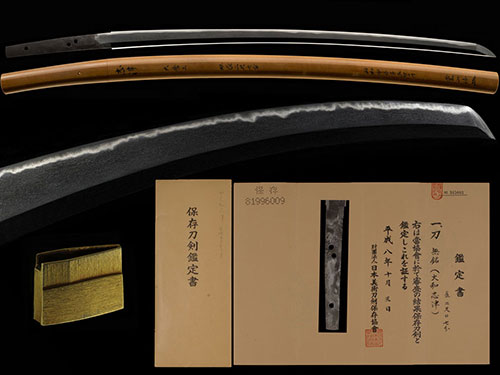
大和志津 刀Yamatoshidu Katana
No.206481大和志津 三郎兼氏 重要候補 金筋長く頻りに掛る名品 古刀最上作 薫山鞘書 二尺七分Yamatoshidu Saburou Kaneuji Juyo Candidate Kinsuji hangs long over and over a masterpiece Koto's best work, Kunzan scabbard 62.8cm
ご成約Sold
- 極めKiwame
- 大和志津Yamatoshidu
- 登録証Registration
- 宮城県 Miyagi 昭和57年8月12日 8/12/57(Showa)
- 時代Period
- 南北朝時代Nanbokucho period
- 法量Size
-
刃長 62.8cm (二尺七分) 反り 1.7cm
元幅 2.9cm 先幅 1.9cm 元重 0.72cm 鎬厚 0.78cm 先重 0.48cm 鋒長 3.5cm 茎長 17.4cm 重量 593gHachou 62.8cm (二尺七分) Sori 1.7cm
Moto-Haba 2.9cm Saki-Haba 1.9cm Moto-Kasane 0.72cm Shinogi-Thikess 0.78cm Saki-Kasane 0.48cm Kissaki-Chou 3.5cm Nakago-Chou 17.4cm Weight 593g - 国Country
- 大和Yamato
- 姿Shape
- 鎬造、庵棟、身幅尋常、反りやや深く、中鋒やや延びる。Shinogidukuri, Iorimune, Standard Mihaba, Slightly deep Sori, Chu-Kissaki slightly extended.
- 鍛Kitae
- 板目肌に、杢目・流れ肌交じり、地沸微塵に厚くつき、地景よく入り、乱れ映りたつ。Itamehada, Mokume, Mixed Nagarehada, Jinie entered fine and thick, Chikei entered well, Midare-Utsuritatsu
- 刃文Hamon
- のたれに、互の目・小互の目交じり、足よく入り、小沸深くよくつき、金筋長く頻りにかかり、砂流しかかり、匂深く明るく冴える。Notare, Gunome, Mixed small-genome, Ashi entered well, Small-Nie entered deeply, Kinsuji hangs long over and over, Sunagashi-kakari, Deep Nie is bright and clear.
- 帽子Boushi
- 乱れ込んで小丸。Midarekonde-Komaru
- 茎Nakago
- 大磨上、先切、鑢目勝手下り、目釘孔三。Oh-suriage, Sakikiri, Yasurimekattesagari, Mekugiana are three(3)
- ハバキHabaki
- 金着二重。Double gold
- 説明Drscription
- 志津三郎兼氏は、大和手掻派の刀工で、当初は包氏と銘し、後に美濃国多芸郡志津(現岐阜県海津市南濃町志津)に移住した際に兼氏と改銘したと伝える。しかし、包氏の在銘物には初代兼氏よりも時代の下るものしか見られず、兼氏同人とみられるものはすべて無銘極めとなる。兼氏の師伝については、古来より正宗門として正宗十哲の一人にも数えられ、現存する作刀からみても正宗からかなりの影響を受けており、充分首肯できるものである。兼氏の作風は、大和伝を基調としたものと相州伝を基調とした二様があり、前者を大和志津、後者を志津として極めている。この刀は、中鋒やや延びる鎌倉末期から南北朝初期の体配で、地沸がキラキラと微塵に厚くつき、地景よく入り、乱れ映りたち、柾がかり肌立つ美しい地鉄に、金筋長く頻りに掛る、働き豊かな刃を焼き、匂深く、匂口明るく冴え、大和伝基調に相州伝が混在する典型作で、重要レベルの出来である。Shidu Saburou Kaneuji is a Yamato Tegai swordsmith who was initially named [Kaneuji 包氏] and is reportedly renamed [Kaneuji 兼氏] when he later moved to Minonokuni Tagigun Shidu.Kaneuji's master's biography has been counted as one of Masamunejittetsu as a Masamune gate since ancient times, but even from the viewpoint of existing swords, it is considerably influenced by Masamune, and it can be fully agreed.There are two styles of Kaneuji, one based on Yamatoden and the other based on Sousyuden. The former is Yamato shidu and the latter is shidu.
This sword has Chu-Kissaki is slightly extended from the late Kamakura period to the early Nanbokucho period.Jinie is covered in a thick layer of glitter, Chikei entered well, Midare-UTsuritachi, Masagakari-Hadatatsu in beautiful Jitetsu, Kinsuji hangs long over and over, Burning a blade that works well, Deep Nioi, Nioikuchi is bright and clear.This is a typical work that mixes Yamato-den with Sosyu-den, and is on a Juyo level.


